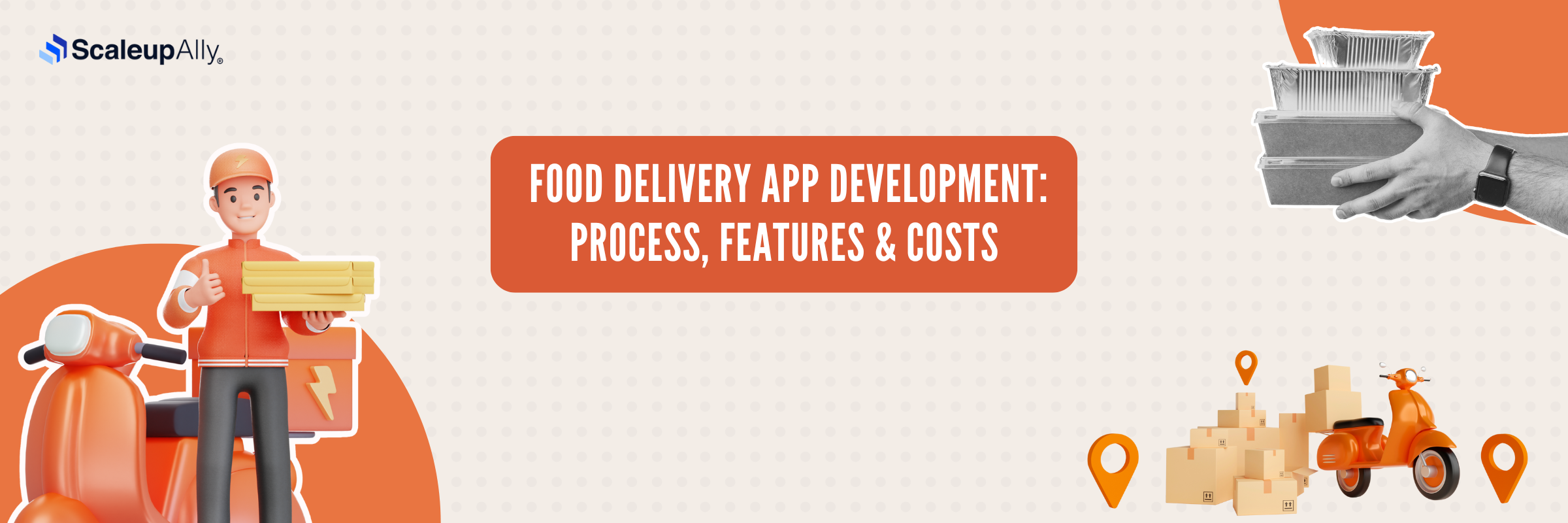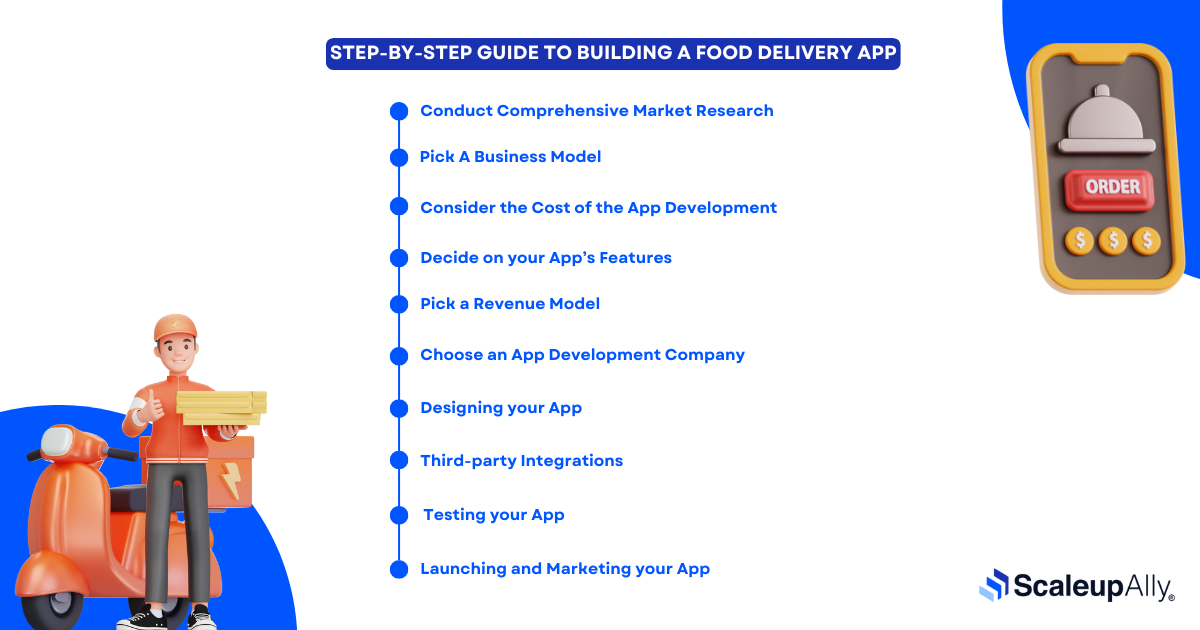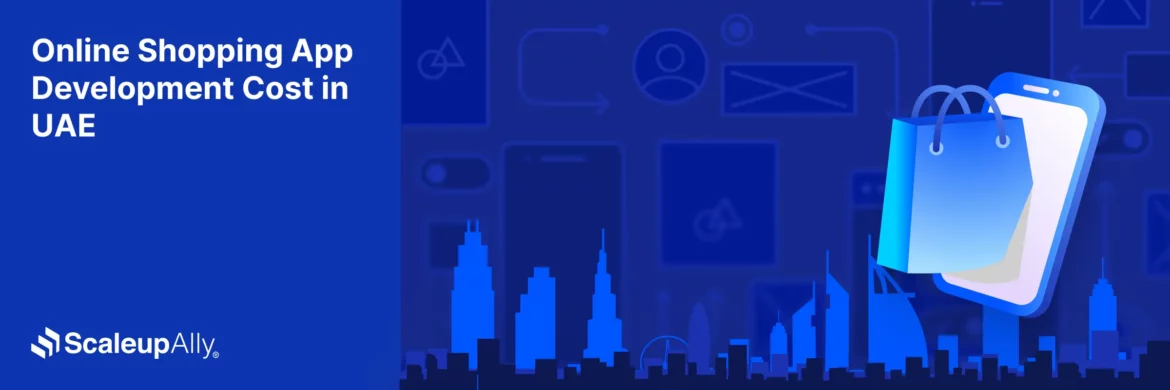
Food Delivery App Development: Process, Features & Costs
Suprabhat Sen | October 27, 2024 , 14 min read
Table Of Content
Driven by the COVID-19 pandemic, the number of food delivery app users in the U.S. leapt to 111 million in 2020. With a projected growth rate of 9.89% through 2025, the market could reach $441.6 billion.
This demand makes developing and investing in a food delivery app a golden opportunity. Awaiting you in this blog is a food delivery app development guide. Read on to seize the moment!
Step-by-Step Guide to Building a Food Delivery App
Seeing the success and demand in the industry, it’s not surprising to aim for the same success for oneself. However, to be successful, you’ll need to do it right. In this section, we will guide you on how you can build the perfect food delivery app.

1. Conduct Comprehensive Market Research
On DoorDash, you can schedule a delivery for later, a convenient feature for people whose work requires so much focus that they forget to order food. The market is high on competition, with competitors constantly releasing new features in order to offer convenience to their users.
This is why it is necessary to conduct market research to understand the needs of your targeted users.
How do the major players with larger market shares meet the needs of their users? What can you learn from them to ensure your own success?
Asking yourself questions like this will provide you with structure on how to begin.
Here’s a tip to get started: read user reviews of the top apps.
This will give you a clear understanding of user expectations. Market research should be the first step on your list, as it forms the foundation for your food delivery app development.
2. Pick A Business Model
The next step is deciding what you want your app to do exactly. Yes, it is a food delivery app, but there are different types of food delivery models.
There’s the aggregator model, where you partner with multiple restaurants and offer a variety of food options for customers to choose from.
So, in this case, the app acts as a middle man between restaurants and consumers. The restaurant is responsible for the food and delivery, and the app earns a commission for connecting the two.
You could also opt for a logistics-focused model, in which you handle deliveries for restaurants without drivers.
Another option is the fully integrated model. Here, you run a cloud kitchen (restaurants that only deliver food) or manage food preparation and delivery services yourself.
Pick whichever option works for you, fits your audience, budget, or the value you’d like to provide.
Or you can envision your own model for a food delivery business.
3. Consider the Cost of the App Development
If you do not have technical skills or team, you will need to outsource the app development process. To be honest, app development isn’t cheap, so if you are a startup, you will need to consider costs carefully, since you may have a limited budget.
Estimating the cost of developing a food delivery app is not as straightforward as it sounds, because the developer(s) will need to assess your requirements first before they can provide you with a figure.
You may also need to consider which platforms you are developing for (iOS and Android), the region you are hiring developers from, and other variables.
To give a general estimation, developing a food delivery app can cost between US$15,000 and US$60,000 on average, but this can change based on the factors mentioned.
To stay competitive, your app needs both basic and advanced features for customers, restaurants, delivery drivers, and administrators. All these add up to the development cost.
This brings us to our next step: choosing your App’s features.
4. Decide on your App’s Features
To be fair, your app’s main role is to facilitate transactions between restaurants and users. You can’t control certain things like food quality and taste.
However, you control the overall user experience of the app or speed of delivery (if you handle delivery).
Providing users with the best experience will retain them, and then you can weed out restaurants with low-quality services based on reviews later. Some key features you should include in your app are user-friendly interfaces for ordering and tracking, a list of restaurants where users can search and filter, a secure payment gateway integration, real-time delivery tracking, reviews & ratings, customer support, loyalty programs, push notifications, and many more.
Additionally, adding features like social media integration, personalized suggestions (now with the help of AI), and in-app chat can improve the user experience and would make your app stand out.
5. Pick a Revenue Model
Unless the food delivery mobile app development is just a hobby for you, you are building this app to make profits.
You’ve done your research, picked a business model, prioritized your features and now the big question is: how will you generate revenue?
For a service app such as this, you have a few options. First, there is the commission-based model.
For every order each user makes on your app, you earn a commission.
Another option is the subscription model. Users pay a monthly or yearly fee to access perks or advanced features of your app.
Another source of revenue is partnering with restaurants or delivery services to run ads on your platform.
Your decision on which revenue model to choose should solely depend on the market, user habits, and your competition.
6. Choose an App Development Company
If you aren’t building the app yourself, you will need to hire a company to do it for you. At this stage, you should be selective, as choosing the wrong company can set you back.
Here are some key criteria your chosen company should meet:
- Experience: The company must have experience in building multiple apps. Their experience will help speed up the development process. It’s a bonus if they have experience in online food delivery app development.
- Expertise: The team should be skilful in all aspects of mobile app development, including front-end and back-end development, third-party API integration (e.g., maps, payments), payment gateway integration, data security and privacy in app development, database management, etc.
- Communication: Communication is crucial. They should keep you updated on the development’s progress and estimated delivery dates.
- Flexibility: App development can involve changes. Your team must be able to adapt easily to new changes or requirements.
7. Designing your App
A beautifully designed App will impact the user experience. It should be visually appealing, with matching colors and a clean layout, easy to navigate and search, quick to order, and much more.
Users should be able to customize their profiles and receive personalized recommendations based on their reviews, preferences, geographic location, and other factors. A user-focused design will improve the experience and increase the chances of your food delivery app being a success.
8. Third-party Integrations
Coding takes a lot of time and time is of the essence in launching your app. That being said, not every feature of your app needs to be coded from scratch. There are a few features you can integrate into your app to speed up the development process.
- A secure payment gateway to handle transactions.
- Mapping and geolocation services to help you make delivery successfully.
- SMS or push notifications to send order progress.
- APIs from restaurants to access their menus and inventory.
9. Testing your App
This phase is the most important in the entire lifecycle of food app development because you get to feel users’ frustrations and fix these problems firsthand before your app goes out there.
Focus on your app’s performance on different devices or operating systems and how secure it is.
Thoroughly testing and fixing bugs in your app will help make it safe, reliable, and easy to use.
10. Launching and Marketing your App
This is the final step in your food delivery app development process. You need a plan to promote your app after its launch. Your plan should include:
- Create a brand identity for your app.
- Run ads to reach your customers.
- Engage users on social media.
- Partner with local restaurants to drive growth.
Key Features to Include in a Food Delivery App
Here are some features that are a must for your food delivery app.
- User Registration and Profile: Users should be able to sign up and easily set up their profiles.
- Restaurant Listings: There should be a list of nearby restaurants for users to choose from.
- Menu Browsing: Browse restaurant menus with detailed options.
- Search and Filters: Quickly search restaurants with filters for cuisine, ratings, and price.
- Order Tracking: Track progress on order status and delivery location.
- Payment Integration: Availability of secure multiple payment options (credit, debit, wallet).
- Discounts and Offers: Offer special deals, promo codes, and loyalty rewards to loyal users.
- Order History: Track past orders and let the user reorder their favorite meal with a single tap.
- Push Notifications: Alerts for offers, order updates, and new arrivals.
- Ratings and Reviews: User feedback on restaurants and food quality.
- Customer Support: In-app chat or call for order issues and inquiries.
- Scheduled Orders: Option to pre-order meals for a later time.
- Multiple Delivery Addresses: Save multiple delivery locations.
- In-app GPS and Delivery ETA: Live location and estimated delivery time of ordered meals.
- Social Sharing: Let them share favorite dishes or restaurants on social media.
Technologies to Use for Food Delivery App Development
Building a food delivery app requires a strong technological foundation. Here are some technologies you should consider when developing your app:
- Mobile Development Frameworks (React Native, Flutter): These frameworks allow developers to build apps for both iOS and Android from a single codebase, reducing time and costs.
- Backend Development (Node.js, Django, Ruby on Rails): These technologies provide server-side solutions for efficient data management, user authentication, and API development to connect with the front end.
- Database Management (MongoDB, PostgreSQL, Firebase): These databases store and manage user data, order history, and restaurant information, with options for real-time updates.
- Cloud Services (AWS, Google Cloud, Azure): Cloud platforms offer hosting, data storage, and serverless computing solutions, ensuring the app can handle varying loads without performance issues.
- Payment Gateways (Stripe, PayPal, Square): These services facilitate secure online transactions, allowing users to pay conveniently while ensuring compliance with security standards.
- Geolocation Services (Google Maps API, Mapbox): These tools provide location-based services, enabling users to find nearby restaurants, track deliveries, and get accurate estimated times of arrival.
- Push Notification Services (Firebase Cloud Messaging, OneSignal): These services allow for real-time communication with users and send alerts for order updates, promotions, and other important notifications.
- Analytics Tools (Google Analytics, Mixpanel): These tools help track user behavior, app performance, and order trends, providing insights to improve user experience and app functionality.
- User Authentication (OAuth, JWT): These technologies secure user accounts through token-based authentication, ensuring that user data and accounts are protected during login and transactions.
Cost Breakdown for Building a Food Delivery App
Developing a food delivery app involves several cost components. Here’s a cost breakdown of the primary expenses you need to consider:
1. Market Research and Planning
As your first step in the development process, you will need to conduct research to assess your chances of success.
This will involve analysing your competition, understanding target users, and defining the app’s features and market strategy.
You could either do this in-house or seek the services of external research conductors.
Estimated cost: US$2,000-10,000
2. Design and Prototyping
Before the app gets coded, you will need to design the user interface first. This may involve some cost depending on which platform you choose to design your UI.
Examples of such platforms and tools include Adobe XD and Figma.
Estimated cost: US$3,000-15,000
3. Mobile App Development
Hiring a team to develop both the front end and back end of the app for its associated platform (iOS or Android) will involve some costs.
This will also depend on your required features and the location of your development team.
Estimated cost: US$15,000 – 50,000 (per platform)
4. Backend Development
Setting up servers, databases, and APIs for data management, user authentication, and payment processing.
Estimated cost: US$10,000-30,000
5. Payment Gateway Integration
You will need to collect payments for your service rendered to the customers as well as pay restaurants and delivery partners, if applicable.
For this you would need a secure payment gateway. Some popular examples include PayPal, Stripe, RazorPay, etc.
Estimated cost: US$1,000 – 5,000
6. Testing and QA
Quality Assurance Analysts will thoroughly test your app to identify and fix bugs, ensuring a smooth user experience and app functionality.
Estimated cost: US$3,000 – 10,000
7. Deployment and Launch
Deploying the app to app stores involves costs, as does marketing it would do.
Estimated cost: US$1,000 – 5,000
8. Maintenance and Updates
You will occasionally need to update the app, fix bugs, and ship new features based on user feedback.
Estimated cost: US$1,000 – 5,000 (monthly)
9. Marketing and Promotion
Budget for digital marketing, social media advertising, and promotional campaigns to attract users.
Estimated cost: US$5,000 – 20,000
10. Legal and Compliance
Legal expenses for contracts, terms of service, privacy policies, and compliance with local regulations.
Estimated cost: US$1,000 – 5,000
Total Estimated Cost
- Low-End Estimate: $42,000
- High-End Estimate: $155,000
How can Scaleupally Help you in Building Food Delivery Apps?
When we started our journey over six years ago, our goal was to provide the best services possible to our clients, and that hasn’t changed.
At ScaleupAlly, our dedication to offering end-to-end restaurant IT services remains unwavering.
We specialize in creating cross-platform solutions using React Native and Flutter, ensuring smooth functionality on both iOS and Android.
We integrate secure payment gateways like Stripe, PayPal, or RazorPay for safer transactions.
Additionally, we implement real-time GPS tracking and order updates for live order and delivery statuses.
Even after your app is delivered, our partnership doesn’t end there. We continue to offer support, regular updates, and bug fixes to keep your app running.
We are your ally in bringing any idea you have to life. Even if your concept feels unclear, we will help you analyze and refine it until it’s ready for development. Schedule a free consultation with us today, and let’s get started.
A journey of a thousand miles begins with a single step.
Conclusion
Food delivery apps have become very popular in recent years, with industry giants like Swiggy, Zomato, Uber Eats, Grubhub, Just Eat, and Domino’s leading the market.
As we’ve explored, developing a successful food delivery app requires meeting certain criteria.
Following these steps will give your app the potential to compete in this growing industry and provide significant value to both customers and restaurants.
So, what are you waiting for? Take that leap of faith.
Frequently Asked Questions
Q: How much does it cost to build a food delivery app?
The cost of building a food delivery app ranges from US$41,000 to US$155,000, depending on features, platform (iOS/Android), and design.
Q: How is AI used in food delivery apps?
AI is used in food delivery apps for personalized recommendations, route optimization, customer service chatbots, and demand forecasting.
Q: What technologies are best for building a food delivery app?
Technologies like React Native, Flutter, Node.js, MongoDB, AWS, Google Cloud, and Stripe are commonly used. These provide cross-platform development, scalable backend architecture, real-time order tracking, and secure payment integration.
Q: How long does it take to build a food delivery app?
Building a food delivery app typically takes 4 to 9 months, depending on the complexity of features, customization, and the size of the development team.
References:
Related Blogs

Top 20 Emerging Technologies of 2026
Discover the top 20 emerging technologies of 2026. Explore which innovations are driving change across healthcare, finance, manufacturing, and other crucial industries.
ScaleupAlly Team
Dec 16 ,
9 min read

Online Shopping App Development Cost in UAE | Pricing & Factors Explained
Understand UAE online shopping app development costs in 2025 with pricing ranges, influencing factors, hidden fees, timeframes, and expert savings tips.
Suprabhat Sen
Nov 29 ,
13 min read

Software Development Timeline: Phases, Duration & Estimation Guide
Understand the software development timeline with phase durations, key factors, hidden delays, and practical methods to estimate project time.
Suprabhat Sen
Nov 29 ,
16 min read


